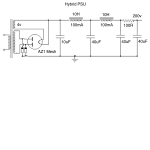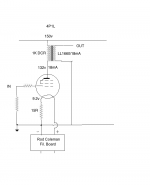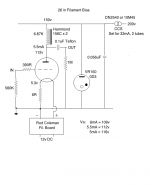Hi Ale,
So are you just using one Salas board for both chanels, then an individual CCS VR per side?
How does it perform and sound compared to no SSHV?
Charlie
So are you just using one Salas board for both chanels, then an individual CCS VR per side?
How does it perform and sound compared to no SSHV?
Charlie
Just a recap on filament cables. For a 1 metre run twisted pair screened it looks like DMX512 which is 22AWG, 7/30 or 7/.025mm. This is overall screened. It's used extensively for digital lighting and uses 5 pin XLRs, with pin 1 ground as usual and 2+3, 4+5 for the pairs. I'm thinking this is a good solution. Belden 8723 is widely available too and is individually screened with a drain wire. Also OK if you decide on 22AWG which should be OK for short runs. Data says 22AWG is 1 amp cable but also 7 amps in equipment.
20AWG would probably be nicer - haven't found anything commonly available for that.
20AWG would probably be nicer - haven't found anything commonly available for that.
Hi Ale,
So are you just using one Salas board for both chanels, then an individual CCS VR per side?
How does it perform and sound compared to no SSHV?
Charlie
Yes, only one. Channel separation is from CCS onwards.
Compared to previous incarnation: In my first version of 26 I had an SSHV1 regulator in place. This preamp is quieter, less microphonic but this is due to filament starvation. Bass is deeper and overall tone is rich and pleasant. I need to listen to it more!
I will do some tests when I get the chance to so can show the performance of the regulators, etc.
Ale
Hi Andy,
I typically use umbilicals with 5, 7 or 10 wires (depending on amp) with 1 mm2 cross section which is about AWG17. This is available with screen from a local store. They even have thicker wires. But you probably won't be able to fit such a cable into XLRs
Best regards
Thomas
I typically use umbilicals with 5, 7 or 10 wires (depending on amp) with 1 mm2 cross section which is about AWG17. This is available with screen from a local store. They even have thicker wires. But you probably won't be able to fit such a cable into XLRs
Best regards
Thomas
For HV umbilicals...personally I would pay more attention to the insualtion rating of the wire (and the connectors) used b/4 anything else......for HV I use only Teflon insulated wires......no???
Hi!
Of course the voltage rating needs to be adequate. I considered that as a given. With the voltages in a 26 preamp that should normally not be a problem. The umbilical I use is good for over 600VDC. In amps with higher voltages I make the umbilical myself with double or even triple insulated wires for the HV.
Best regards
Thomas
Of course the voltage rating needs to be adequate. I considered that as a given. With the voltages in a 26 preamp that should normally not be a problem. The umbilical I use is good for over 600VDC. In amps with higher voltages I make the umbilical myself with double or even triple insulated wires for the HV.
Best regards
Thomas
On a whim I decided to upgrade the PSU for my preamp. What a difference! Better detail and tone. I used a large EI 240-200v transformer I had on the shelf. This whole PSU feeds a VR150 voltage reg. Moral of the story - don't neglect the PSU. I should know this. All the caps are polypropylene motor runs. The diodes are UF4007. I suppose I could find something more sophisticated for those, but that was what I had in stock.
Attachments
Last edited:
... What a difference! Better detail and tone...
Just curious -as your new setup is quite elementary*- with what are you comparing?
You're stabilising the HT with a gas tube. One of the advantages of an electronic regulator is in the strong reduction of the influence the PS has on stages with low PSRR. It's not sacred because every power supply (even the battery) has internal resistance and impedance, interacting with the audiosignal imposed on the HT. The amount of the interaction however differs, freeing the bandwith of interest from phase behaviour.
* To reduce the ripple voltage it's more effective to first use a RC filter and next a LC filter. See if you can improve with that in PSUD.
Last edited:
I attach the old PSU - it's actually pretty similar. I can only think that the AZ1 mesh is making some sort of difference - smoother treble and a bit more refined sounding. I heard that on previous occasions when I made the switch. On the other hand, the 80 is no slouch.
Up to now the PSU has been driving a VR150 which feeds the circuit. Actually the preamp now uses 4P1L not 26, but it's in filament bias as well.
Next I inserted a DN2540 before the VR150 in place of the dropper resistor for the VR150. I did this in the 80 PSU, and this PSU now has even more detail than the AZ1 PSU without a DN2540. However, I'm not convinced about the tone in the mids and treble.
It's starting to sound like an active load again - tried that with IXYS and found it a bit bright and tiring. Yes - bass is better, detail is better. I heard that before. But I'm hearing something else - is it possible that the DN2540 is compressing the sound somehow? How could that happen?
Andy
Up to now the PSU has been driving a VR150 which feeds the circuit. Actually the preamp now uses 4P1L not 26, but it's in filament bias as well.
Next I inserted a DN2540 before the VR150 in place of the dropper resistor for the VR150. I did this in the 80 PSU, and this PSU now has even more detail than the AZ1 PSU without a DN2540. However, I'm not convinced about the tone in the mids and treble.
It's starting to sound like an active load again - tried that with IXYS and found it a bit bright and tiring. Yes - bass is better, detail is better. I heard that before. But I'm hearing something else - is it possible that the DN2540 is compressing the sound somehow? How could that happen?
Andy
Attachments
Last edited:
After comparative listening I decided I preferred the VR150 with a DN2540 or IXYS 10M45 CCS, and with a mesh AZ1.
I went back and used this arrangement with my original 26 preamp, which has the two Hammond 156C plate chokes and teflon FT-2 output caps. It's still good, but I miss the treble sparkle of the 4P1L into LL1660/18mA. This may be the capacitor coupling. The mids and bass are fine.
But I have the hummmmm back again with the Hammond chokes. Has anyone using these managed to get them free of hum, and if so how? I'd really like to know!!
Andy
I went back and used this arrangement with my original 26 preamp, which has the two Hammond 156C plate chokes and teflon FT-2 output caps. It's still good, but I miss the treble sparkle of the 4P1L into LL1660/18mA. This may be the capacitor coupling. The mids and bass are fine.
But I have the hummmmm back again with the Hammond chokes. Has anyone using these managed to get them free of hum, and if so how? I'd really like to know!!
Andy
Attachments
I've no experience with Hammond 156C but on another circuit I experimented with series connecting two identical chokes. What I recall is high tones lost detail. Theoretically two caps in series represent a smaller cap, but we're forgetting the choke copper resistance here, presenting a LPF.
I try to get the exact workings of that CCS+VR supply in post 2200 but perhaps it's time to check theory for me again? 🙂
Here the 26 is represented by the R1, R2 combination and the gastube by R3. As I see it, they influence each other in a way that if the 26 starts pulling more current and the current source keeps current stable, the gas tube has to supply current. Is that 150 volt stable over operation?
I try to get the exact workings of that CCS+VR supply in post 2200 but perhaps it's time to check theory for me again? 🙂
Here the 26 is represented by the R1, R2 combination and the gastube by R3. As I see it, they influence each other in a way that if the 26 starts pulling more current and the current source keeps current stable, the gas tube has to supply current. Is that 150 volt stable over operation?
An externally hosted image should be here but it was not working when we last tested it.
Imho totally true Jaap!
When the 26 demands more current, it will come from the VR-tube, probably resulting in less stable regulation (and vice-versa).
I experimented with VR-tubes and found out that regulation gets better when more current flows through them.. So maybe increasing the current throught te CCS to 30mA will give "better" results? (at least, more stable regarding the VR-tube?)
Any ideas someone?
Rob
When the 26 demands more current, it will come from the VR-tube, probably resulting in less stable regulation (and vice-versa).
I experimented with VR-tubes and found out that regulation gets better when more current flows through them.. So maybe increasing the current throught te CCS to 30mA will give "better" results? (at least, more stable regarding the VR-tube?)
Any ideas someone?
Rob
Consider that V-sign the 26 tube and R1 the choke. So, the 26 is loaded by the compound of three devices: A) the choke B) the FET CCS and C) the VR-tube which is bypassed for HF.
Rob, did you ever test those baco 'barrel' chokes for linearity?
Andy, if you leave out one 156C you'd probably not mis low. How's high turning out?
Rob, did you ever test those baco 'barrel' chokes for linearity?
Andy, if you leave out one 156C you'd probably not mis low. How's high turning out?
VR is a shunt, so like a supply with low impedance. CCS is high impedance. The 26 sees the choke load in parallel with the output load...
I'll have to make another 26 preamp with a transformer out so I can compare that with the plate chokes. I have a LL1660/5mA, LL1692/10mA and LL1635/5mA. That would cure the hum and might have better treble. The treble isn't bad with the 156Cs, just a bit soft.
Alrighty, with the output four to count 😉
For a VR to change current it has to change its impedance.
It's a complex load.
Ale, did you compare 26 reproduction against the SSHVSR and a sole resistive load ?
( added to the load presented by the output ).
Andy, mind the distortion product of that penthode which has a different spectrum than the 26.
Ale has probably data on that. It might turn out you're listening for a small amount of uneven harmonics, beafing up highs. Just guessing here.
For a VR to change current it has to change its impedance.
It's a complex load.
Ale, did you compare 26 reproduction against the SSHVSR and a sole resistive load ?
( added to the load presented by the output ).
Andy, mind the distortion product of that penthode which has a different spectrum than the 26.
Ale has probably data on that. It might turn out you're listening for a small amount of uneven harmonics, beafing up highs. Just guessing here.
Last edited:
Rob, did you ever test those baco 'barrel' chokes for linearity?
No, I did not... 🙁
I "only" had Tribute and AE chokes.. 😀
Rob
Pity, I stock a load 😉 Compared to a resistive load I'm under the impression reproduction is in balance BUT hearing can be deceptive :d
I've plotted some points in a graphic once but it was a challenge turning knobs while reading meters. Besides, my bridge was capable for 50mA DC at the most. I once witnessed Remco 'analogaudio' examine random chokes with his $10K spectrum analyzer within seconds. The results were very diverse above 1KHz, most PS chokes presented a hefty bulge. Reason for me to buy established brands audio chokes indeed as there's something more to it than just winding copper.
I've plotted some points in a graphic once but it was a challenge turning knobs while reading meters. Besides, my bridge was capable for 50mA DC at the most. I once witnessed Remco 'analogaudio' examine random chokes with his $10K spectrum analyzer within seconds. The results were very diverse above 1KHz, most PS chokes presented a hefty bulge. Reason for me to buy established brands audio chokes indeed as there's something more to it than just winding copper.
As far as hum pickup is concerned I assume you have tried swapping the choke wires over?
Best,
Susan
Best,
Susan
- Home
- Amplifiers
- Tubes / Valves
- #26 pre amp



